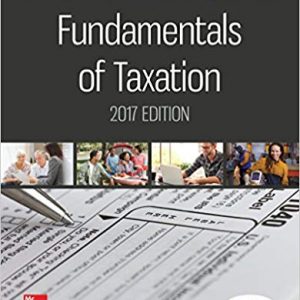No products in the cart.
Taxation
 Loading...
Loading...
Byrd & Chen’s Canadian Tax Principles, 2022-2023, Volume 1, 1st edition Gary Donell Byrd Chen Clarence Byrd Test Bank
Byrd & Chen’s Canadian Tax Principles, 2022-2023, Volume 1, 1st edition Gary Donell Byrd Chen Clarence Byrd Test Bank
Byrd & Chen’s Canadian Tax Principles
( Test Bank)
Byrd & Chen’s Canadian Tax Principles, 2022-2023, Volume 1, 1st edition Gary Donell Byrd Chen Clarence Byrd Test Bank
Edition: 2022-2023, Volume 1, 1st edition
Author Name: Gary Donell Byrd Chen Clarence Byrd
contact:
Whatsapp +1 (949) 734-4773
for the Facebook page click here
for more books for ( Test Bank and Solution Manual) click here
For a Solution Manual click here
sample free
Canadian Tax Principles, 2022-2023 (Byrd/Chen)
Chapter 1 Introduction to Federal Taxation in Canada
 Loading...
Loading...
$44.00 $100.00
Byrd & Chen’s Canadian Tax Principles, 2022-2023, Volume 1, 1st edition Gary Donell Byrd Chen Clarence Byrd Test Bank
Byrd & Chen’s Canadian Tax Principles
( Test Bank)
Byrd & Chen’s Canadian Tax Principles, 2022-2023, Volume 1, 1st edition Gary Donell Byrd Chen Clarence Byrd Test Bank
Edition: 2022-2023, Volume 1, 1st edition
Author Name: Gary Donell Byrd Chen Clarence Byrd
contact:
Whatsapp +1 (949) 734-4773
for the Facebook page click here
for more books for ( Test Bank and Solution Manual) click here
For a Solution Manual click here
sample free
Canadian Tax Principles, 2022-2023 (Byrd/Chen)
Chapter 1 Introduction to Federal Taxation in Canada
1.1 Online Exercises
1) The major source of federal revenues is the personal income tax. Indicate three other types of taxes that contribute to federal revenues.
Answer: The other sources of federal revenues that are shown in Figure 1-1 of the text are:
- Corporate income taxes.
- Non-resident income taxes.
- GST.
- Customs and import duties.
- Other excise taxes.
- EI premiums.
Type: ES
Topic: Federal revenue sources
2) What is the meaning of “person” when the term is used in the ITA?
Answer: In the ITA, the term “person” refers to an individual, a corporation, a trust or an estate.
Type: ES
Topic: Definition – “Person” ITA 248(1)
3) Briefly describe the procedures used in calculating provincial or territorial income tax for individuals in other than individuals residing in Quebec.
Answer: Provincial or territorial income taxes for individuals are calculated by applying a provincial or territorial income tax rates to taxable income for federal income tax purposes. Provincial or territorial personal income tax credits are then applied to the resulting gross income tax. The provincial and territorial income tax brackets may differ from the federal income tax brackets. In addition, provincial and territorial personal tax credits may be different than the federal personal tax credits.
Type: ES
Topic: Income tax payable – federal income tax
4) The Canadian income tax system is often used to achieve various economic objectives. Give three examples that illustrate this point.
Answer: There are many examples that could be cited. The text divides them into resource allocation (e.g., public health care), distribution effects (e.g., federal GST credit), stabilization effects (e.g., deficit reduction), and fiscal federalism (e.g., allocations to various levels of government).
Type: ES
Topic: Canadian income tax system – objectives
5) Provide an example of how taxation policy can be used to influence resource allocation.
Answer: Examples provided in the text are as follows:
- Tax revenues are used to provide public goods and services.
- Excise taxes are used to discourage the consumption of alcohol and tobacco products. There are, of course, many other examples that could be cited.
Type: ES
Topic: Canadian income tax system – objectives
6) The government pays a Canada Child Benefit to the parents of children who are under 18 years of age. The payments are reduced by a percentage of income above a certain amount. What objectives are achieved by this benefit system?
Answer: The Canada Child Benefit system is designed to assist low income families with children. The government is encouraging population growth. In addition the benefits are targeted to those most in need being low income families.
Type: ES
Topic: Canadian income tax system – objectives
7) Indicate three disadvantages of a tax system that uses progressive rates.
Answer: There are a number of possibilities here. They include that progressive rates:
- Increase the complexity of the system.
- Are unfair to individuals with highly variable income streams.
- Are unfair to single income family units.
- Lead to pressure for various types of tax concessions.
- Discourage high income individuals from making additional efforts.
- Encourage tax evasion.
Type: ES
Topic: Canadian income tax system – objectives
8) A regressive tax is one that taxes high income individuals at lower effective rates. Explain why a sales tax levied at a flat rate of 8% can be regressive.
Answer: While the sales tax rate is the same for all individuals without regard to their income level, lower income individuals normally spend a higher percentage of their total income. Since the sales tax is charged on the amounts spent, this means that the sales tax paid by lower income individuals represents a larger percentage of their total income. As a consequence, they are generally considered to be regressive in nature.
Type: ES







There are no reviews yet.